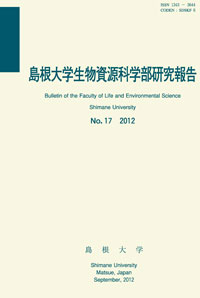島根大学生物資源科学部
ISSN:2435-0885(オンライン)
ISSN:1343-3644(冊子体)
なお、冊子体の刊行は23巻まで
ISSN:1343-3644(冊子体)
なお、冊子体の刊行は23巻まで

ダウンロード数 : ? 件
この文献の参照には次のURLをご利用ください : https://ir.lib.shimane-u.ac.jp/3510
島根大学生物資源科学部研究報告 4
1999-12-20 発行
Response of the Rice Sekiguchi Lesion (sl) Mutant, cv. Sekiguchi-himenomochi, to Magnaporthe grisea
ファイル
内容記述(抄録等)
Pathological response of the rice Sekiguchi lesion (sl) mutant (cv. Sekiguchi-himenomochi) originated from cv. Himenomochi (resistance gene Pi-k) to M. grisea was investigated. When the rice sl mutant was inoculated with M. grisea spores, large differences in hyphal growth were seen in rice cells and lesions formed on the leaves among M. grisea strains. When wild (cv. Himenomochi) and sl mutant (cv. Sekiguchi-himenomochi) rice plants were inoculated with incompatible M. grisea races, hyphal growth was very poor in rice sheath cells of both mutant and wild rice plants. On the other hand, only Sekiguchi lesions were formed on leaves of the mutant, although only necrotic spots appeared on those of the wild rice. In M. grisea races compatible with a wild rice (cv. Himenomochi), hyphal growth was not inhibited in leaf-sheath cells of both mutant and wild rice plants. On the other hand, both Sekiguchi and blast lesions formed on the leaves of the sl mutant, although necrotic and blast lesions formed on the leaves of the wild rice plant. Many spores were produced on blast lesions. However, no sporulation was observed on the Sekiguchi lesions, even though the size of the Sekiguchi lesions was larger than that of blast lesions. These results indicated that the Sekiguchi lesion formation is a manifestation of a resistant response of the rice sl mutant to M. grisea, and that the rice sl mutant, cv. Sekiguchi-himenomochi, has a blast resistance gene Pi-k.
About This Article
Other Article
PP. 1 - 6
